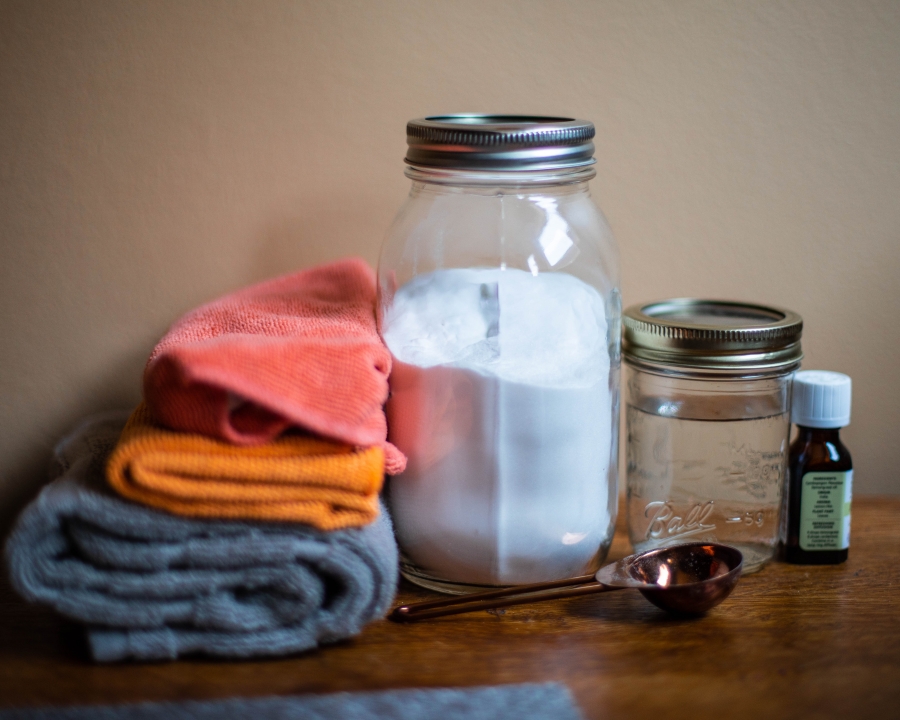Toxicity can lurk in any household, and I’m not talking about unhealthy relationships and behaviors. Unfriendly chemicals are at the ready to aid with our home cleaning needs; even laundry detergents can fall prey to substances recognized as hazardous by the CDC.
Minimizing toxicity in the home can be invaluable if you have kiddos wandering around trying to get into cabinets and unscrew lids of curious substances. A low-toxicity home is also likely to be more energy efficient and environmentally conscious; one could argue that a non-toxic home is also more cost-effective in the long run!
I’ve already written a post about how to select non-toxic household cleaners. Yet there are other strategies to keep in mind to keep toxicity out of all areas of your home, not merely your linen closet.
Here are some tips you can implement today to ensure that your home is kid-friendly, free of harmful chemicals, and low-impact.
Get Comfortable Reading Labels
Food products aren’t the only consumer items with ingredient lists. Cleaners, hygiene and beauty products, and soaps of all kinds—nearly unanimously—display active and inactive ingredient lists.
To keep toxicity out of your home, get extra comfortable reading these lists. Recognize that some cleaners may not list all of their ingredients in a visible place—you may have to peel back a label or parse through fine print to find the “inactive ingredients” some products don’t list prominently. (Active ingredients accomplish a specific task, such as “exfoliation;” inactive ingredients act like vehicles or carriers for these.)
Know what to look out for when reading these labels. In general, avoid products that contain known hazards such as ammonia, chlorine, and phthalates (particularly in high concentrations). You’ll have to do a little more research to learn more about other suspicious ingredients, such as those that lurk in beauty and hygiene products. (Sulfates, parrafin wax, parabens, and synthetic fragrances are often culprits here.)
Learn to be suspicious of labels that say “all natural” or simply “organic.” These descriptors are not necessarily indicators of a 100% non-toxic substance, unfortunately.
Prioritize Hypoallergenic Items
“Hypoallergenic” is a descriptor applied to products that are less likely to contain common allergens, particularly those related to respiratory issues and skin exposure. This is a valuable descriptor for beauty products such as cosmetics, as these substances tend to linger in pores for extended periods of time.
Even if you and your family don’t have any known allergies to chemicals or substances, look for products that are labeled hypoallergenic. “Dermatologist recommended” products may also be priorities here.
Some shampoos and soaps will also be labeled as “baby-friendly” or tearless. Even if you aren’t caring for a newborn anytime soon, you may want to check out these products for greater guarantee of low-toxicity.
Be Cautious with Beauty Products
With that in mind, it’s important to note that the cosmetics industry is highly unregulated. Even products that are hypoallergenic or plant-based may contain ingredients that aren’t listed on the label (yes, this happens) or those that appear to be low-toxicity but actually are harmful.
Remember when traces of lead were discovered in lipstick, relatively recently?
When buying beauty products, be particularly cautious. Yes, these products often come in small packages, and some individuals only apply small amounts on a daily basis. Yet even mild exposure to certain chemicals can pose health hazards.
I recommend looking for companies offering products with vegan, eco-friendly, and/or biodegradable ingredients. Products without synthetics and artificial ingredients are also likely to be non-toxic. Believe it or not, there are a variety of makeup companies out there that are striving to offer transparent, non-toxic products to clients like 100% Pure.
Don’t Forget Technology
Substances aren’t the only things carrying toxins. Exposure to blue light in computer and cell phone screens can also negatively impact sleep cycles, mental health, and eye function.
Wearing blue light reduction glasses can aid in this exposure, particularly if you have to stare at a computer screen for hours at a time.
Create Boundaries
Many arts and crafts products, stains, thinners, and workshop substances come laden with toxins, many of which can be immediately harmful if inhaled in vapor form. If you must use these products, be sure to create needful boundaries within the home.
For example, confine these products to highly ventilated, well-secured storage rooms. Be sure to use mouth, nose, and eye protection when using these. Otherwise, I highly encourage you to seek out non-toxic alternatives. It’s possible to find a variety of paints, thinners, and stains that are low in toxicity, for example; learn more about these here.
Go the DIY Route
One way to guarantee a 100% non-toxic home is to embrace DIY cleaners, beauty products, and more. I make my own fabric softener, for example, and shaving cream. Others have found luck crafting their own toothpaste, household cleaners, and even makeup products!
The beauty of DIY cleaning and hygiene products lies in the simple fact that they are not likely to cause harm if accidentally ingested, rubbed into eyes, or poured onto skin. My fabric softener, for example, consists of baking soda, vinegar, and essential oils, none of which pose hazards to the human body. An entirely DIY, minimalist cleaning closet very likely does not require childproof locks or hinges for this reason.
Plunging into the DIY world can be intimidating, especially if you would rather just buy the items themselves for the sake of time. Yet I encourage you to spend time on DIY household sites for inspiration. DIY substances are also likely to be kinder to your wallet in the long run and contribute to a low-waste home.
In general, one of the best ways to ensure a non-toxic or low-toxicity home is to be mindful of everything you bring through your front doors. Knowledge is power here; research brands, companies, and ingredients before you buy so that you can feel confident in your chemical-free home.
What steps are you taking to keep toxicity out of the home?








